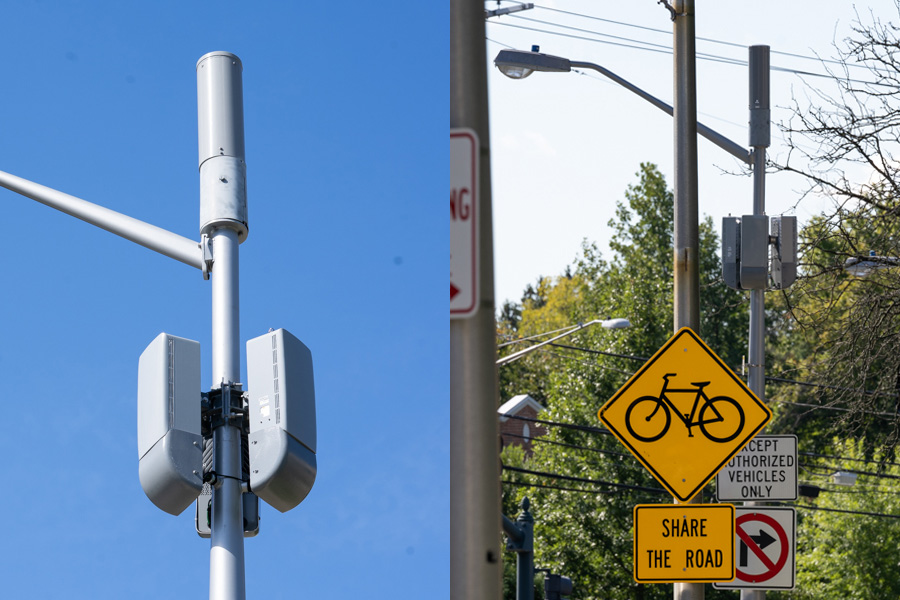Small Cell Antennas
Since 2018, the council has approved two Zoning Text Amendments (ZTAs) to address issues related to small cell antennas that impact County residents. The ZTAs have been approved to remove barriers to deployment of cell towers to benefit Montgomery County residents and to bring the County up to current standards in compliance with federal regulations, specifically with the Federal Communication Commission’s (FCC) Small Cell order.
The Council approved ZTA 18-02 on May 15, 2018. This ZTA focuses on telecommunications in mixed use and non-residential zones. Next, the Council approved ZTA 19-07 on July 21, 2021, which facilitates the deployment of next-generation wireless infrastructure in Montgomery County via wireless small cell (also known as “5G”) antennas on utility and light poles that will offer faster speeds, enhanced reliability and greater capacity. Next, the Council approved ZTA 22-01 on October 25, 2022, which facilitates the deployment of antennas on existing structures.
The ZTA’s also facilitate the County’s compliance with Federal Law. The County’s previous regulations for small cell antennas in the Agricultural, Rural Residential and Residential Zones likely did not comply with the Federal Communications Commission (FCC) Small Cell Order.
The ever-increasing demand for mobile broadband services combined with the evolving technical needs of the wireless industry required legislative action for the County to maintain its competitive edge. The ZTA’s offer a balanced approach with provisions that protect the community's interest in managing the commercial use of public property and maintaining attractive and safe roads and neighborhoods.
A robust 5G network will provide greater access for underserved populations and contribute to all County residents’ quality of life by providing opportunities for innovation and advancement in multiple sectors, including health care, education, transportation, agriculture and entertainment.
The Council also approved requirements for preferential placement of wireless infrastructure, language to minimize the loss of trees with all installations and limits on pole proliferation by preventing a small wireless installation within 150 feet of a facility occupied or controlled by the same carrier.
Residents with questions on cell antennas in Montgomery County may also refer to a list of frequently asked questions (FAQs). The list includes a breakdown of the ZTA, information on what 5G is, an explanation of federal and local laws on the matter, the FCC’s role, and more.
What is allowed under the current law?
ZTA 19-07 allows certain telecommunications towers as a limited or conditional use in certain residential zones; revises the standards for telecommunications towers allowed as a limited or conditional use; revises the conditional use findings required for the replacement of a pre-existing pole; and generally amends the use requirements to address certain telecommunications towers. ZTA 22-01 reduces the setback for Antenna on Existing Structure in the Rural Residential, Residential, or Planned Unit Development zones from 60 feet to 30 feet.
Unlike the large installations of previous cell towers, which could be as tall as 100 feet, 5G requires smaller equipment installed closer together and much closer to the ground. Unlike the macro towers, which were located on private property, small cell facilities tend to be located in public rights-of-way.

For installation, an antenna is installed either on top of or flush with a pole, usually a pre-existing streetlight or utility pole. The antenna receives and transmits wireless signals from wireless devices. A cabinet holds the equipment necessary to process the wireless signals for multiple wireless carriers. The cabinet can also be a separate box on the ground. Due to the weight of the installation, it is sometimes necessary for a replacement pole to be put up that may be taller than the original streetlight or utility pole.
The zoning measure allows poles with antennas as a limited use, if the antenna would replace a preexisting utility, streetlight or site plan-approved parking light pole. The replacement pole must be at least 30 feet from the nearest habitable building with conditions for screening and design as well as height restrictions based on the width of the right-of-way. Poles less than 30 feet from the nearest habitable building require a modified conditional use process with a public hearing.
ZTA 19-07 also creates a waiver and objection process for new poles, if no existing pole is within 150 feet. This process also applies to applications for poles higher than the limited use standard but under 50 feet. The waiver and objection process requires a public hearing when an objection is filed.
Resources
Council staff report on ZTA 22-01
FAQ on cell antennas in Montgomery County
Press release announcing passage of ZTA 19-07
Press release announcing passage of ZTA 22-01
Transmission Facilities Coordination Group (TFCG/Tower Committee)
Office of Zoning and Administrative Hearings (OZAH) Rules and Procedures for applicants and objectors
ZTA 18-02 as a PDF document
ZTA 19-07 as a PDF document
ZTA 22-01 as a PDF document
